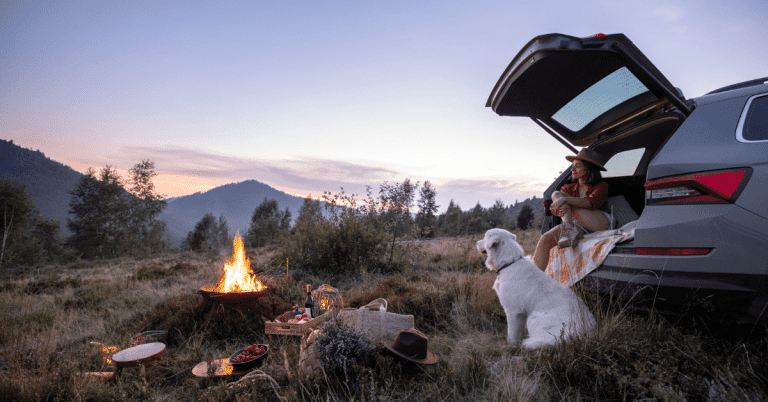There’s no one that would be more happy to join you on your next camping trip than your canine companion.
All those places to discover, flowers to sniff and territories to mark.
This is a new adventure for the both of you, and to enjoy it to the fullest, you need to be prepared.
In this article, I’ll share with you some things I’ve learned over the years from taking my dog camping all around the country.
Read on!
Table of Contents
TogglePreparing For A Camping Trip With Your Dog
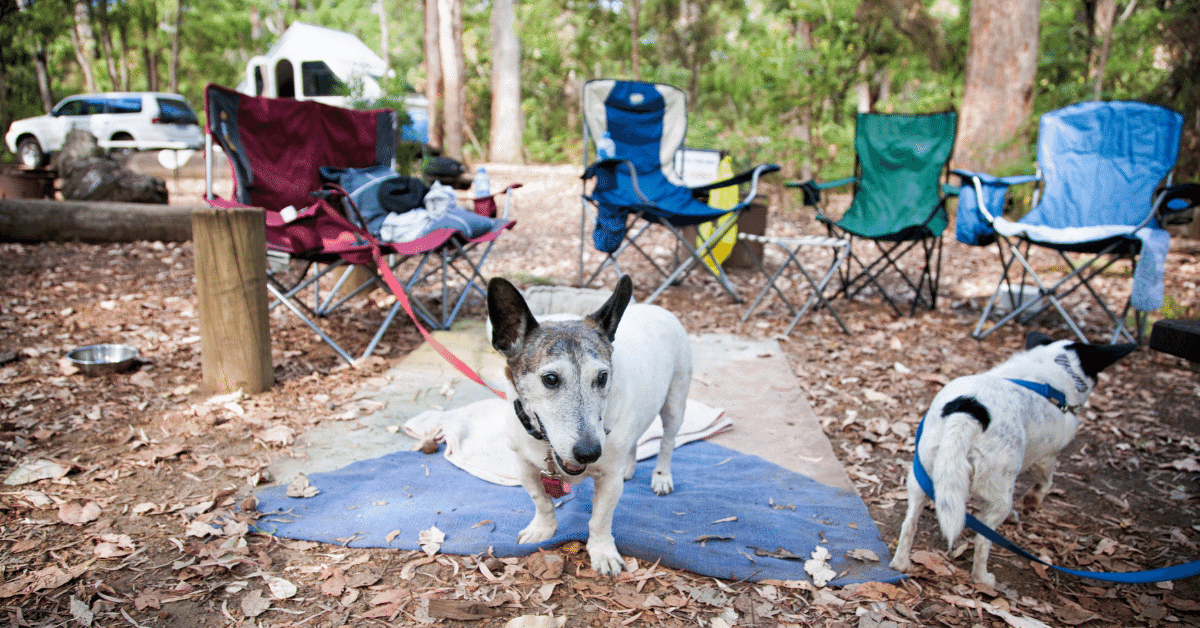
Camping with your four-legged friend can be an amazing outdoor adventure, but only if you’re well-prepared.
These are the things you should do to assure your pooch stays happy throughout your camping trip and enjoys it as much as you do.
Researching Campground Rules And Regulations
It’s hard to imagine that there are campgrounds that wouldn’t be honored by your dog’s presence.
But sadly, it’s true – not all campgrounds are pet friendly.
Now, I’m sure you don’t want to arrive at your destination only to be greeted with a No Pets Allowed sign.
That’s why you should always check a campground’s policy regarding pets before you book.
In most cases, your dog is required to be on a leash 24/7. Certain places are rigorous, and they restrict the leash length to 6 feet.
Others might allow a dog to be off leash as long as they respond well to recall commands.
Finding a pet friendly campsite might be even harder if you’re wild camping. Most national parks don’t allow camping with dogs.
What’s more, they might not even allow them on hiking trails in some places.
Choosing A Dog Friendly Destination
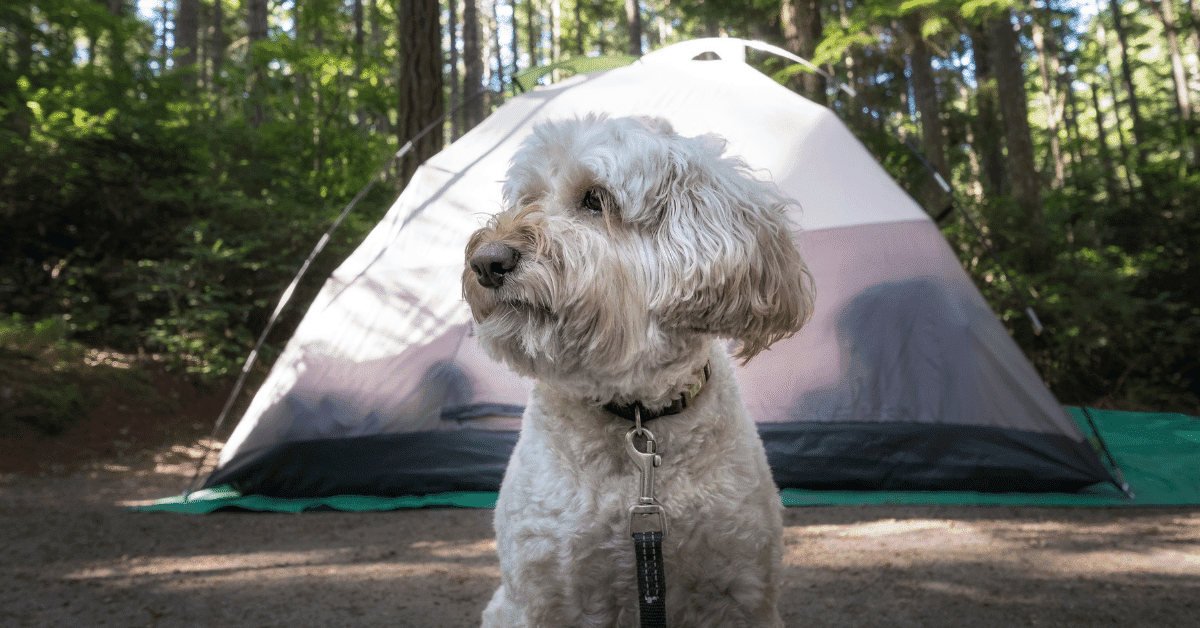
You might’ve found a pet friendly campground, but what about the rest of the area?
Pick a location that has pet friendly hikes nearby, so that you can take your dog for walks beyond the campground lot.
Your pooch might enjoy the cool breeze through an open window in your car. But I assure you, no dog is a fan of really long car rides.
So before you choose a campground that’s 500 miles away, be sure your dog can cope with the long journey.
Take Your Dog To The Vet For A Checkup
If it’s been a while since you’ve taken your dog for a checkup, book an appointment prior to your camping trip.
You want to be sure your pup is safe from all potential threats when out in the wilderness.
Most campgrounds require pets to be up to date with vaccinations. That makes sense, considering that some of the wild animals might be potential transmitters of rabies.
That doesn’t mean that you’ll encounter infected wild animals wherever you go. You probably won’t, but it’s always better to be safe than sorry.
Don’t forget about ticks and fleas either. These annoying creatures hide in the grass waiting to latch onto our canine companions.
Protect your pet with either a topical solution, a chewable tablet or a collar.
Gear To Pack When Taking Your Dog Camping
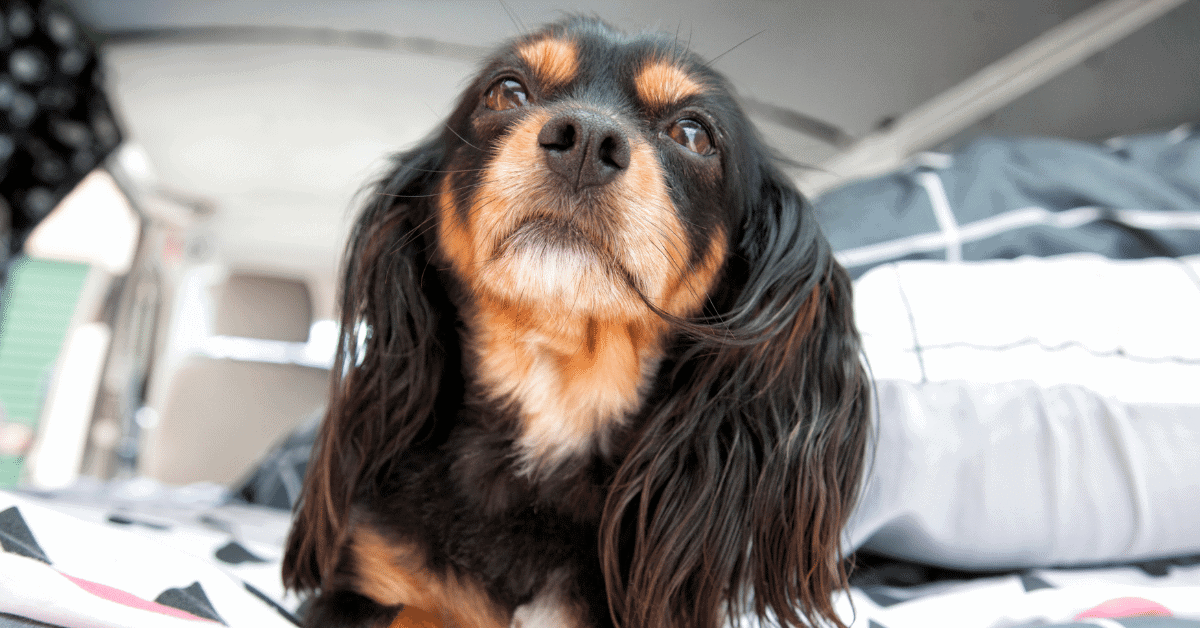
Aside from your standard camping equipment, you need to pack your dog’s camping gear too.
Here’s a checklist of the most important things your pooch needs while on camping:
- Food and water bowls
- Food – I prefer using kibble because it’s lightweight and doesn’t spoil easily.
- Your dog’s leash – whether a retractive leash is allowed or not depends on the campground. You should also pack an extra leash just in case the first one breaks.
- Dog camping bed – you can pack an extra sleeping bag to use as a dog bed, or bring your pooch’s own dog bed from home instead. Or you can invest in a dog sleeping bag. They’re compact and very comfortable.
- A set of towels – there’s always a possibility of rain. And to prevent your stuff from getting muddy, you’ll need towels to dry off your canine camping companion.
- Dog first aid kit
- Dog treats
7 Tips For Camping With Your Dog

Camping with my dog is my favorite way of de-stressing.
But I would be lying if I said the first few trips weren’t chaotic.
Here are a few things I wish I knew the first time I took my dog camping.
Plan Your Travel Route According To Your Dog’s Needs
Driving cross country to reach the campground?
You need to plan stops along the way for your dog to potty, eat, drink and stretch their legs.
Look up the route online, and see where there are some good spots to take a break.
Gear Your Dog Up
Aside from packing the essentials I mentioned in the previous section, there are a few other things you should pick up from the pet store.
The first one is a foldable bowl. It’s featherweight and takes up practically no space.
If your dog will be on leash a lot of the time, you’ll also need a harness. It gives your dog more freedom of movement without causing strain on the neck.
If you are planning on hiking far and want to cary your dog, you’ll want to get a good dog backpack carrier.
And finally, my absolute favorite is a dog backpack. This is especially great for working breeds. These dogs love having a purpose, and in this case, that’s carrying their own food and water.
My dog, who’s a working breed, loves to alternate between pulling like crazy and taking ages to sniff a bush on daily walks. But as soon as I put a backpack on him, he’s instantly focused on the road. He walks right beside me and keeps a steady pace.
The best hiking companion I’ve ever had!
Don’t Leave Food Out
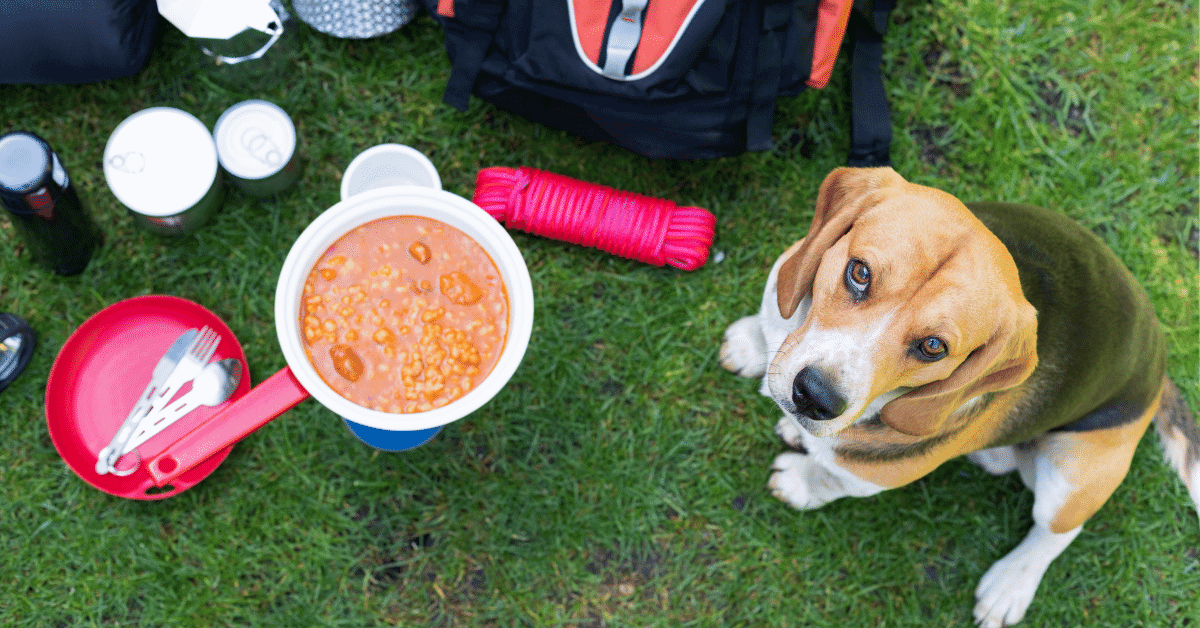
Don’t leave a full bowl of food laying around.
If your dog is done eating for the time being, pick up the leftover kibble and store it in an airtight container.
Leaving food out can attract ants and even bears, and that’s definitely something to avoid.
Further Reading: How To Protect Yourself From Bears While Hiking
Nighttime Visibility
An LED collar can prove to be quite useful, even when the dog is on a leash at all times.
I’ve stumbled over a dog’s leash in the dark too many times to count.
I can’t help being clumsy, but I sure can be more careful if I can locate my dog in the dark.
Pick Up After Your Dog
The principles of Leave No Trace apply to all campers, dogs included.
You might think there’s little chance someone will step into your dog’s poop dumped in the bush over there.
But that’s not the main reason for picking it up.
Dog poop, just like humans, can contaminate soil and water sources, so picking it up in a poop bag and disposing of it respsonsibly is a must.
Stay On Track With Hydration
You should have a water bowl filled up at all times. Let your dog drink freely whenever they feel like it, rather than just giving them the occasional drink.
All that outdoor exercise makes our canine friends thirsty. And most of them are sloppy drinkers, so half the bowl gets spilt all over the place anyway.
A rule of thumb is to give your dog an ounce of water per pound of weight each day. And this is just a guideline for dogs that spend most of the day snoring on the couch.
For a pup that’s enjoying the outdoors to the fullest, even more water is needed.
Beware Of Pathogens
A thirsty dog will run up to the closest puddle to take a sip.
But natural water sources are also home to millions of pathogens that cause all kinds of diseases, like giardia.
I’m aware that you can’t control your dog’s every move – but you should prevent them from drinking from stagnant water whenever possible.
Keeping Your Dog Safe While Camping
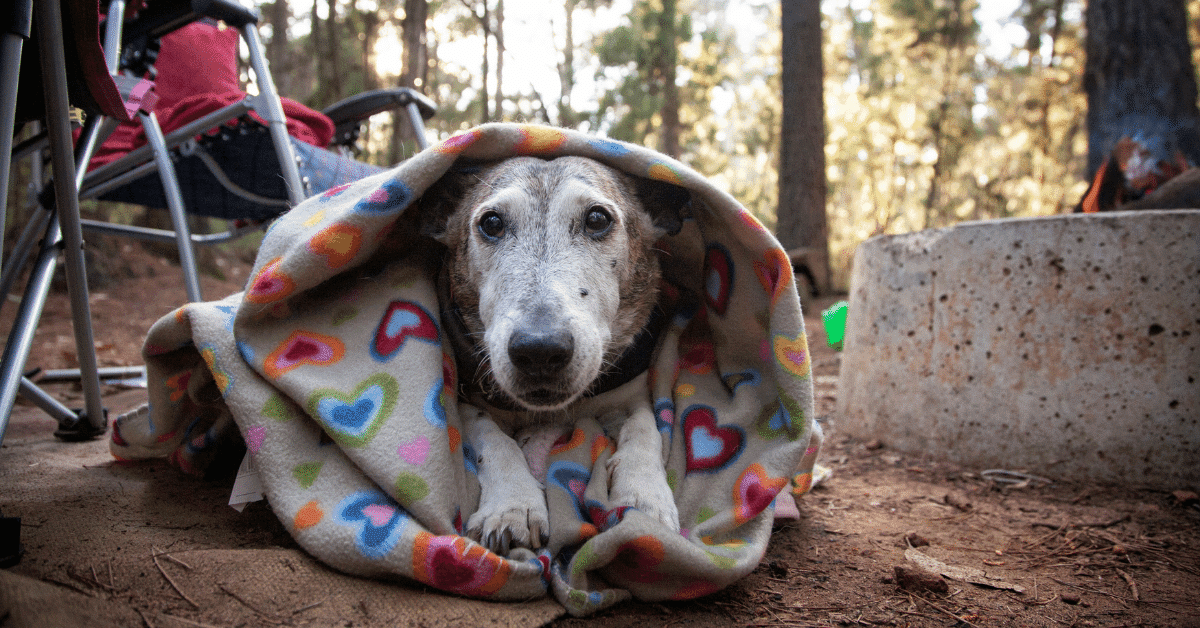
You can never be prepared for everything that can happen when you’re out in the wild.
But, there are few precautions you can take to keep your dog safe while camping.
Minimize The Chance Of Losing Your Dog
For identification purposes, your dog should wear an ID tag on their collar at all times, and they should have a microchip.
Why both?
Anyone can check an ID on a lost dog’s collar, but not everyone will take a lost dog to the vet to check for a microchip.
On the other hand, an ID might fall off the collar. A microchip is an identification option that never fails, as long as someone gets your dog to a vet.
Protect Your Dog’s Paws
Ice, rocks, cold ground and hot pavement are all rough on your dog’s paws.
But there are a couple of things you can do to protect them.
Your first option would be to get your dog boots. But keep in mind that some dogs get used to them sooner than others. Some will just downright refuse to wear them, and that’s okay.
You can also protect your dog’s paws by using a pad balm. Usually made of petroleum jelly, a balm prevents damage to paw pads, while soothing and repairing cracked pads.
Know The Symptoms Of Overheating
Dogs easily overheat in searing summer temperatures.
During the hottest part of the day, keep your dog away from the direct sun and make sure they have plenty of drinking water.
Keep a close eye on overheating symptoms. They include:
- Panting
- Heavy breathing
- Weakness
- Disorientation
- Agitation
- Dry gums
If you notice any of these symptoms, check your dog’s temperature right away. Your pet first aid kit should contain a thermometer. Anything higher than 104 degrees is alarming.
Get ice packs to help your dog cool down.
If that doesn’t help, you should take them to the vet right away.
To Sum Things Up
Heading out into the wild with your four-legged furry friend requires some preparation in order for everything to go smoothly.
From finding a dog friendly camping location to gearing up your pooch for hitting the trail, there are many things to think about in advance.
But as long as you follow these tips, you can rest assured the two of you will have a great time.
If you’re looking for a dog to be your new hiking buddy, check out our article on the best dog breeds for hiking.


